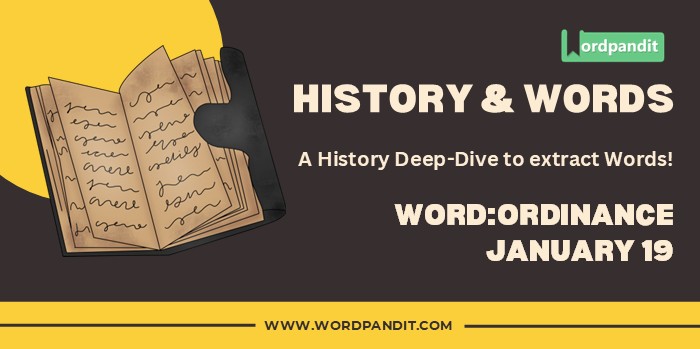History & Words: ‘Ordinance’ (January 19)
Welcome to ‘History & Words.’ 🌟 I’m Prashant, founder of Wordpandit and the Learning Inc. Network. This series combines my passion for language learning with historical context. Each entry explores a word’s significance on a specific date, enhancing vocabulary while deepening understanding of history. Join me in this journey of words through time.
📚 Table of Contents
🔍 Word of the Day: Ordinance
Pronunciation: /ˈɔːrdɪnəns/ (OR-di-nuhns)
🌍 Introduction
On January 19, 1861, the state of Georgia adopted its Ordinance of Secession, becoming the fifth state to formally withdraw from the Union. This historic document, like many similar ordinances passed during this period, demonstrated the profound power that legal declarations could wield in shaping the course of history.
The word “ordinance” represents more than just a legal decree or regulation. It embodies the formal expression of authority, the codification of rules that govern societies, and sometimes, as in the case of Georgia’s secession, the power to challenge existing political structures.
In the context of American history, ordinances have served as crucial instruments of governance, from the Northwest Ordinance of 1787, which established the pattern for American territorial expansion, to local ordinances that shape daily life in modern municipalities.
🌱 Etymology
The word “ordinance” traces its roots to Middle English “ordenaunce,” derived from Old French “ordenance” and Latin “ordinantia,” meaning “ordering” or “arranging.” The term originally referred to the arrangement or ordering of things, later evolving to specifically denote authoritative orders or decrees. This evolution reflects the growing complexity of governance and the need for formal mechanisms to establish and maintain social order.
📖 Key Vocabulary
- 🔑 Secession: The formal withdrawal of a state from a union or federation, as exemplified by the Southern states’ actions in 1860-1861
- 🔑 Legislative Act: A formal decision, statement, or rule made by a legislative body or authority
- 🔑 Municipal Code: A collection of ordinances that govern a specific city or local jurisdiction
- 🔑 Sovereignty: The supreme power or authority from which ordinances derive their legitimacy
- 🔑 Ratification: The formal confirmation or adoption of an ordinance by the appropriate authority
🏛️ Historical Context
The concept of ordinances as formal declarations of authority dates back to ancient civilizations. In medieval Europe, royal ordinances served as a primary mechanism for monarchs to exercise their power and establish law throughout their kingdoms. The Ordinance of Labourers of 1349 in England, for instance, attempted to regulate wages and labor conditions following the Black Death.
In colonial America, ordinances played a crucial role in establishing governance structures. The New England colonies, in particular, relied heavily on local ordinances to maintain social order and religious conformity. The Salem witch trials of 1692-93 were conducted under colonial ordinances regarding witchcraft.
The Northwest Ordinance of 1787 stands as one of the most significant ordinances in American history. It established a system for territorial expansion and governance that would shape the growth of the United States, setting precedents for the admission of new states and the prohibition of slavery in the Northwest Territory.
⏳ Timeline
- 1215: Magna Carta establishes precedent for written legal declarations
- 1787: Northwest Ordinance passed by the Confederation Congress
- 1832: South Carolina’s Ordinance of Nullification challenges federal authority
- 1861: January 19 – Georgia adopts Ordinance of Secession
- 1865: Ordinances of Secession declared void after Civil War
- 1866: Reconstruction ordinances begin reshaping Southern states
🌟 The Day’s Significance
January 19, 1861, marked a crucial moment in American history when Georgia, through its Ordinance of Secession, formally declared its separation from the Union. This action demonstrated how ordinances could be used to challenge existing political structures and assert state sovereignty.
The Georgia Ordinance of Secession was drafted and debated in a convention of elected delegates, highlighting the formal and deliberative nature of such declarations. The document’s language was careful and legalistic, reflecting the belief that secession was a legal right of sovereign states.
The passage of this ordinance had immediate and far-reaching consequences. It contributed to the momentum of secession across the South and helped precipitate the Civil War. The document’s formal nature gave the act of secession a veneer of legal legitimacy that its supporters used to justify their actions.
🔮 Modern Usage and Reflection
Today, ordinances continue to play a vital role in governance, particularly at the local level. Municipal ordinances regulate everything from zoning and building codes to noise levels and public behavior. While modern ordinances rarely carry the dramatic weight of secession declarations, they remain essential tools for maintaining social order and implementing policy decisions.
The term has evolved to primarily denote local government regulations, though it retains its broader meaning of authoritative decree. Environmental ordinances, for instance, have become increasingly important as communities address climate change and sustainability challenges.
🏛️ Legacy
The legacy of historic ordinances, particularly those related to secession, continues to influence discussions about states’ rights, federal authority, and the nature of the American union. These documents serve as important historical sources that illuminate the legal and political thinking of their time.
The system of local ordinances established in American governance has become a model for other nations, demonstrating how local authority can function within a federal system. Modern ordinances addressing issues like civil rights, environmental protection, and public health demonstrate the continuing evolution of this form of legislation.
🔍 Comparative Analysis
While nineteenth-century ordinances often dealt with fundamental questions of sovereignty and political organization, contemporary ordinances typically address more practical aspects of governance and daily life. However, the basic principle remains constant: ordinances represent the formal expression of legitimate authority to regulate human behavior and social interactions.
💬 Quote
“An ordinance to dissolve the union between the State of Georgia and other States united with her under a compact of government entitled ‘The Constitution of the United States of America.'” – Opening line of Georgia’s Ordinance of Secession, January 19, 1861
💡 Did You Know?
🎓 Conclusion
The story of ordinances, from ancient decrees to modern municipal regulations, reflects the evolving nature of governance and authority. The events of January 19, 1861, demonstrate how these legal instruments can be wielded to challenge existing power structures and reshape political relationships. As we continue to face new challenges requiring formal responses from governing bodies, understanding the history and significance of ordinances remains crucial for comprehending how societies organize and regulate themselves.
📚 Further Reading
- 📘 “Georgia in the Civil War: Journey to Secession” by Michael P. Johnson
- 📗 “American Ordinances: From Colonial Laws to Modern Governance” by Richard J. Ross
- 📙 “The Language of Law: Legal Ordinances in American History” by Mary Sarah Bilder












